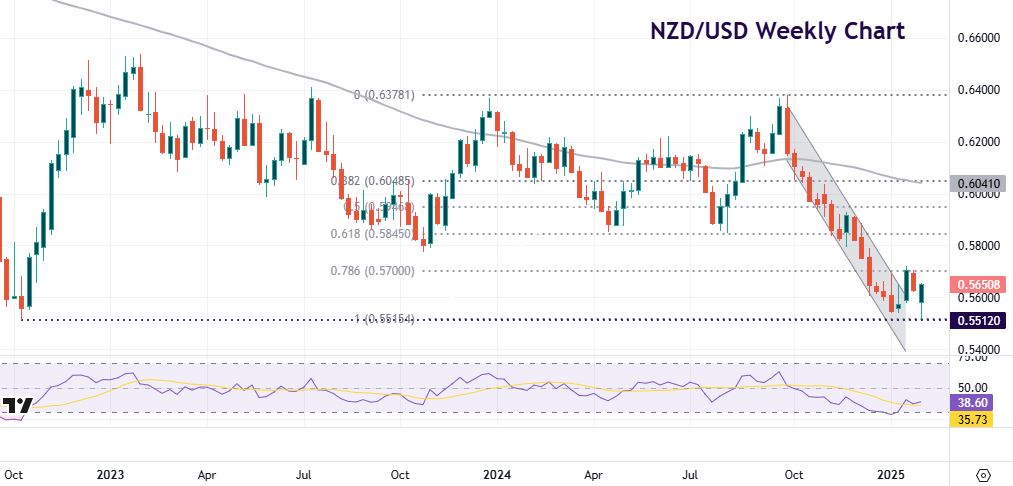Risk sentiment improves, USD eases after tariff tantrum

- USD eased modestly as markets await a US-China tariff agreement
- Tech led stocks higher as the risk mood calmed
- Alphabet, Google’s parent traded down 7% after it released disappointing Q4 earnings
- Gold continued higher, printing another record peak at $2845
FX: USD traded higher to kick off the day but then saw selling through the European session. Trading was relatively calmer with headlines less volatile and risk sentiment improved. A call between President Trump and China’s Xi didn’t take place but markets were not put off. JOLTs data was much softer than expected, ahead of Friday’s NFP. It seems Trump is open to discussion on tariffs, though we have to contend with his highly unpredictable reaction function.
EUR enjoyed a second day of buying as the major tries to advance up to the key long-term level at 1.0448, which is the October 2023 cycle low. The EU is braced for tariffs which they hope to negotiate. A key difference for Europe is that concerns from the US are not border related, but instead around trade balances which potentially take longer to discuss.
GBP continued higher and closed in on the late January year-to-date top at 1.2523. Sterling was described by one investment bank as a ‘safe haven’ among pro-cyclical currencies on Monday. PM Starmer’s trip to Brussels was also well-timed as markets like any possible UK reconnection with the eurozone.
USD/JPY slid as buyers of the yen look to break through support at 153.70/78 and then 153.40, ahead of the 200-day SMA at 152.78. The yen underperformed most other majors as the tariff threats receded.
AUD advanced again as China tariffs and retaliatory measures were not seen as escalating into a major trade war. USD/CAD sold off again with the loonie the top performing G10 major currency. After huge volatility on Monday and a 22-year high at 1.4792, prices are firmly back in the lower part of the recent 1.43-1.45 range. The tariff hammer was delayed for at least a month, but uncertainty still reigns.
US stocks: The benchmark S&P 500 closed in the green, provisionally up 0.72% at 6,037. The tech-laden Nasdaq settled higher, up 1.13% at 21,546. The Dow Jones finished up 0.3% at 44,556. Tech led the gainers with most of the Mag 7 up between one and two percent. Google parent Alphabet reported after the closing bell. The stock traded down over 7% initially after it disappointed with its Q4 earnings.
Asian stocks: Futures are generally in the green. Stocks traded higher as the region reacted to Trump’s one-month delay of tariffs with Canada and Mexico. But the additional 10% tariffs on China took effect and prompted immediate retaliation by China. The ASX 200 was initially led higher by strength in tech and miners but ultimately closed virtually unchanged. The Nikkei 225 briefly climbed back above the 39,000 level with the biggest gainers and losers dictated by earnings releases. The Hang Seng surged amid hopes that China would also reach a tariff deal with the US but then briefly wobbled after China announced tit-for-tat tariffs against the US.
Gold was in demand with a fourth straight of buying. Prices are overbought but that state can carry on longer than most think possible. One strategist called gold “the everything hedge”.
Day Ahead – New Zealand Jobs, US ISM Services
The NZ jobless rate is expected to print at 5.1% in the September quarter, from the prior 4.8%. The labour market is continuing to soften, and along with easing price pressures and inflation should mean an ongoing slowdown in wage growth. A rate cut is strongly priced into the next RBNZ meeting in February and this data shouldn’t decisively change the bank’s thinking.
US ISM non-manufacturing is seen rising to 54.3 from 54.1 in January. Services activity has remained in expansionary territory since July 2024 and doing the heavy lifting for the economy over a more subdued manufacturing sector. That said, Monday’s latest figures saw the headline number move above 50 and into expansionary territory for the first time in 26 months. Higher input costs and selling price inflation in the services sector remain broad-based.
Chart of the Day – NZD/USD bounce reinforces strong support
The RBNZ’s next policy meeting is two weeks away, after a near three-month gap since the November monetary policy statement. There’s around a 70% chance of 50bps rate cut, according to money markets, with roughly 115bps of total easing in 2025. Inflation is back within the bank’s target range, so growth is now the focus.
Of course, the kiwi is in the crosshairs of global growth, trade and tariffs. Prices have been a long-term bear channel since running into resistance at previous highs around 0.6378. The major sunk to the major cycle low from October 2022 at 0.5512 and has bounced strongly since tariffs on Canada and Mexico were delayed. Initial resistance is at 0.57 with the January high at 0.5722 reinforcing this area.

